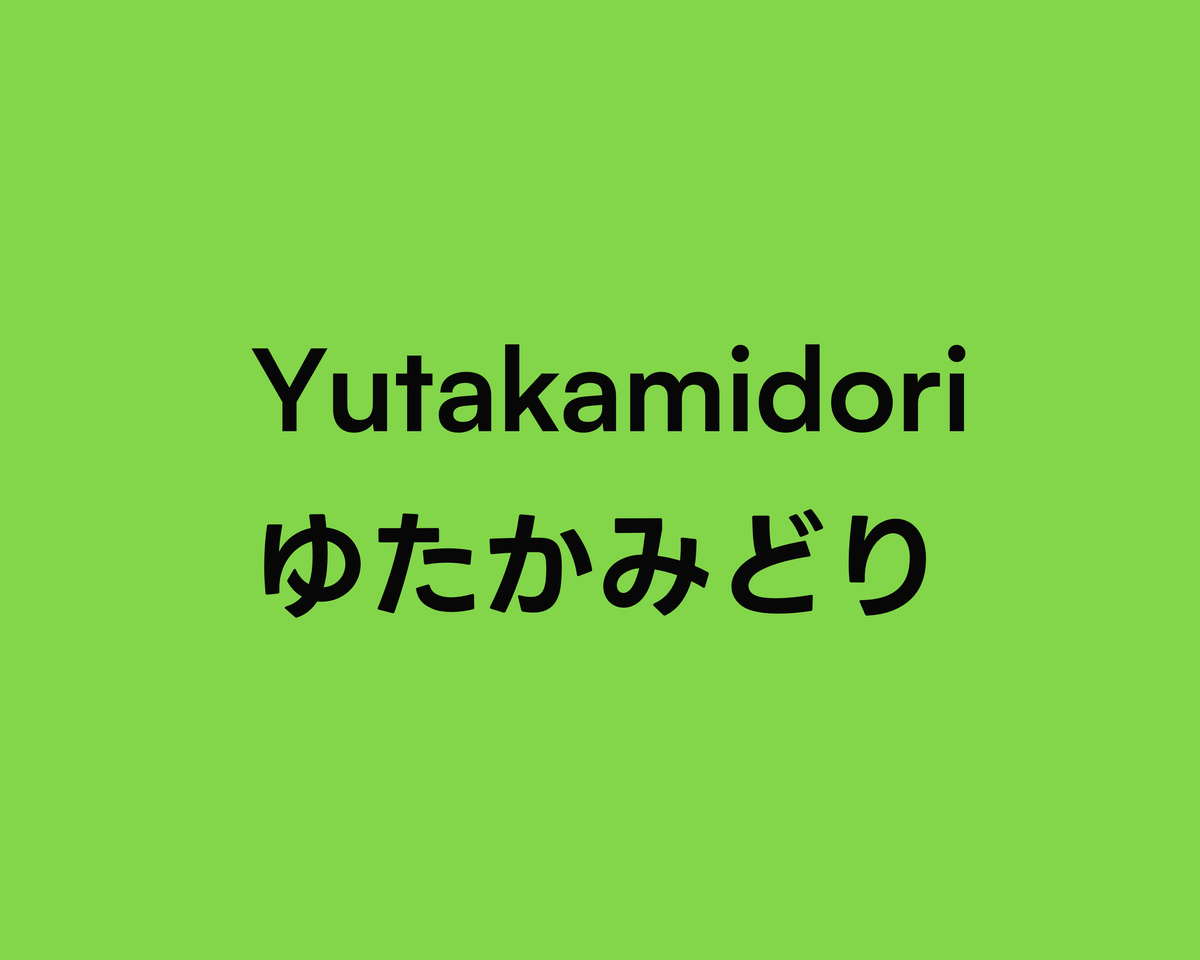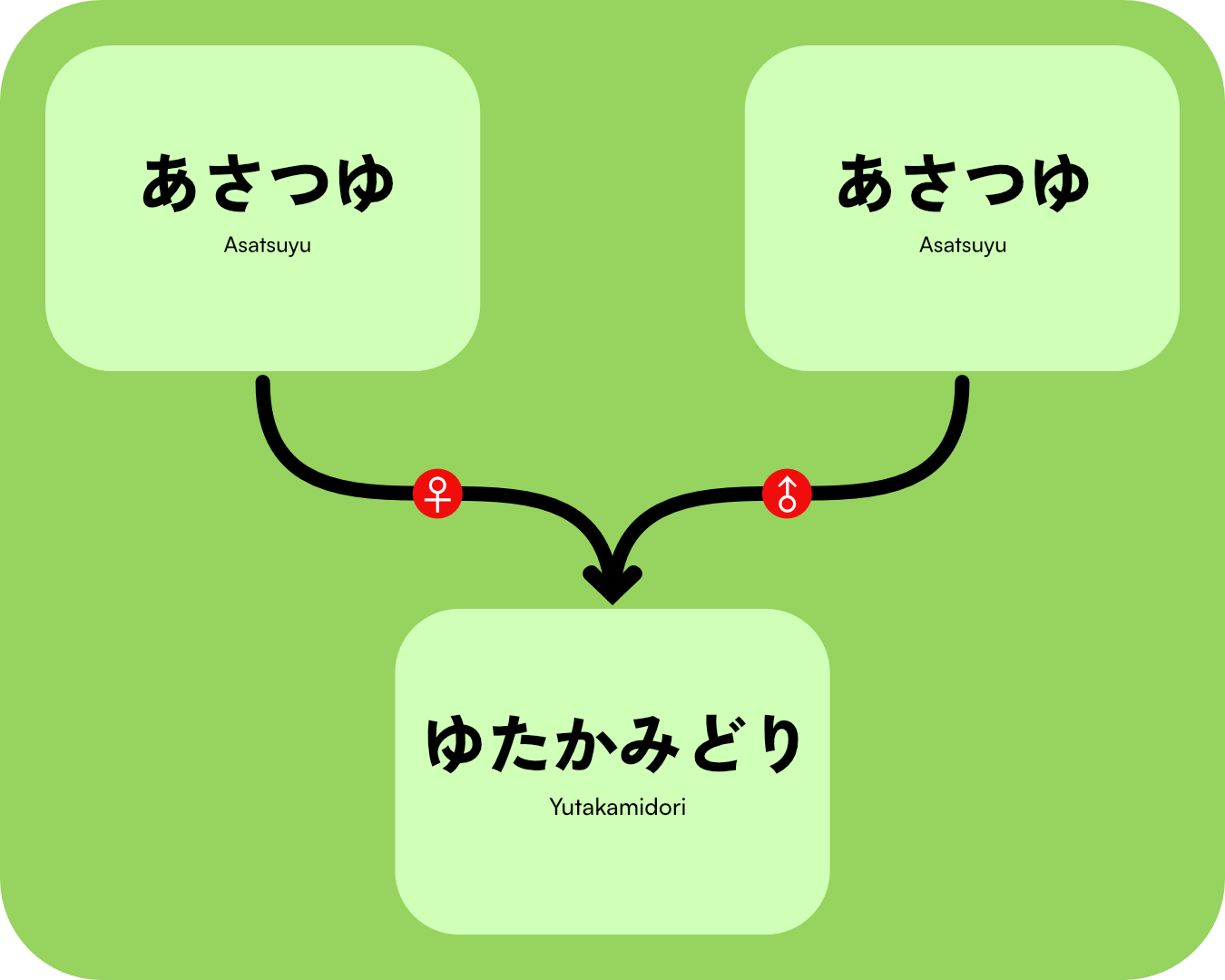Yutakamidori ゆたかみどり
A seedling was selected out of a self-pollination crossing of the Asatsuyu cultivar. The pollination was performed in 1934, and Yutakamidori was selected out in 1949. In 1950, it was named...

Genealogy
♀: Asatsuyu あさつゆ
♂: Asatsuyu あさつゆ

Self-pollination crossing
History
A seedling was selected out of a self-pollination crossing of the Asatsuyu cultivar. The pollination was performed in 1934, and Yutakamidori was selected out in 1949. In 1950, it was named U14-1, and from 1952 renamed as Y2 during its growing tests at the national tea research station, nowadays, the Kanaya National tea research centre under the management of NARO in Shizuoka. It was then tested nationwide in the adaptability tests from 1954. Although it was never registered, making the research of information on this cultivar difficult, it is the second most cultivated cultivar in Japan, although far away from Yabukita. Information on Yutakamidori is scarce and revolves mainly around a few particular topics.
Those include, its large prevalence in the Kagoshima Prefecture, where it represents around 30% of the total cultivated land, closing in to the 40% cultivated area of Yabukita. Yutakamidori is the second most grown cultivar in Japan at around 7% according to 2020 data. Seen from a different perspective, around 95% of the cultivation of Yutakamidori is located in Kagoshima prefecture. One important factor might be its weakness against cold, making it a cultivar mainly found in the southern areas of Japan, which have less occurrence of frost periods. It is also an early cultivar, making the management of its weakness against cold difficult. Its usage is predominantly for sencha, in particular deep steamed methods are used to enhance and develop a nicer taste profile. Shading is also mentioned as a key technique to suppress the production of astringent compounds. Which are mentioned several times in the little material about Yutakamidori I could find, marked astringency and off colour are some usual mentions. Which through deep steaming and high firing temperatures develops a much mellow sweeter and nutty experience, although it appears that those unorthodox processing methods were not explored during its testing phase.
All these factors combined are probably reasons that amounted to not being selected for official registration. This did not stop it from becoming number two in cultivated area or being one of the promoted cultivars for the Kagoshima Prefecture in 1966, which named the cultivar Yutakamidori. A guess for the origin of the name could be from Minoru Shimonodozo's son, Yutaka Shimonodozo. Minoru Shimonodozo allegedly played a key role in the popularization of Yutakamidori, especially in the processing side. The name could be a play of Minoru’s son and the meaning of the Japanese word yutaka, which translates to abundant, plentiful. Or just a name used as a descriptor for such a high-yielding cultivar. I have read a few different sources with different information, so it is difficult to pinpoint the exact reason. I tend to believe the naming comes just as a description of the high-yielding characteristics of the cultivar, like many other names like Okumidori, regarding its late growth characteristics. That said, some cultivars grown from individual farmers use names of sons and daughters when naming them.
Breed in Shizuoka, grown in Kagoshima
The history of Yutakamidori is, as an unregistered cultivar, a challenge to explore. I will be exposing here some material I could find on the topic, which relies on quite heavily in the content of Shimonodozo, a big tea company in Kagoshima and a thesis exploring the evolution of tea businesses. There are a few details that appeared intriguing and consistent enough to warrant mentioning, but please take everything with a pinch of skepticism when reading all the writing in this article.
As mentioned above, the initial crossbreeding was performed in the mid-30s, then studied from the 50s onwards. At some point, a researcher from the Kagoshima Prefecture Tea Research Station, Okamura Katsuro 岡村克郎, is the one that is credited with bringing the strain Y2 from Shizuoka to Kagoshima. Creating an interest in the farmers of Kagoshima about a new cultivar that was promising, the cultivar that would eventually become Yutakamidori. Early growth with good yields, something that took the interest of farmers quickly. Okamura Katsuro was involved in breeding other cultivars, like Asanoka あさのか, registered in 1996. After the initial fields were developed, production time came, which applying the usual processing techniques lended into an astringent tea that was also a bit more reddish in tone. The kind of characteristics that would not do well in the auction, and the taste was described as barely tea.
There was a lot of backlash from the farmers, this cultivar, together with a big push towards increasing the production and the quality of the area in Kagoshima, represented the hopes and dreams of a generation of Kagoshima tea farmers. Kagoshima prefecture at the time basically produced tea as a bulk agent and sent to Shizuoka or Uji to be sold, it was considered a cheap, low-quality bulking agent. Kagoshima had been growing tea for many years, with the Shimazu clan spearheading the cultivation in the Kagoshima area and making it one of its main products. The production of the area did not start to grow to the current levels until after the second world war, when a lot of land became available for cultivation, reconverting it from other uses.
Together with a push for developing black tea production in the area, as well as suitable black cultivars, there was a push for increasing the quality of the green tea production in the area. That also included a push towards moving past the quality reputation of the area. This is why, when the first harvest for Yutakamidori came up, with underwhelming characteristics, there was a lot of backlash from the farmers. The amount of effort required to plan entire new fields and grow them to a harvestable stage requires great effort as well as time, at least 3–5 years before you can do a small test harvest. Okamura Katsuro was a key person promoting the cultivar for the region and perhaps the one who took most of the frustration from the farmers. Here is where Minoru Shimonodozo comes into play, according to the little information I could find.
After many trial and error, using the common producing techniques for other teas with that cultivar. It seems Minoru started developing a more unorthodox approach to the processing, with much more heat involved. Kagoshima is now well known for its deep steaming and heavy firing processing, resulting in a more bold and sometimes nutty characteristics in the dry leaf. This deep steamed techniques started to develop around the 1950s - 1960s. A bit after the breeding of Yutakamidori, and this technique seems not to have been increasingly used until mid-60s to early 70s. You can see how these timings of deepstmamed tea and the developments Minoru applied to try to improve Yutakamidori's teas could have overplayed pretty well. Unfortunately, this is mainly speculation on my part, but deep steaming can round a tea together with shading technique, which also translates to hiding certain off flavours in some cases too.
Nonetheless, the exploration of the high-temperature processing, together with the application of shading techniques to the Yutakamidori bushes to preserve more of the sweetness and improve colour brought the Yutakamidori back into the game. It appears that the tea was a hit and the usage of Yutakamidori increased considerably. It is still far away from Yabukita, with only around 7% of the total production in Japan, and almost all of it is located in Kagoshima prefecture, which grows around 95% of it. According to 2012 data, it comprised a 28% of the finished tea in the prefecture against the 37% which is Yabukita. This is out of an approximate, 26000 tons produced in the prefecture the same year.
Characteristics
Yutakamidori is a cultivar primarily used for sencha, or kabuse in particular, with deep steamed styles with high firing. Yutakamidori is an early budding cultivar, with good yield, more astringent than Yabukita and weak against cold. Its early budding characteristics together with a weakness against cold weather is one of the main reasons is grown mostly grown in Kagoshima or southern regions. In terms of pests, it is a cultivar resistant to antrachnose.
Due to being an unregistered cultivar, there is not a lot of publicly available information available in terms of bush behavior in different growing conditions like in other posts I have written before. I had the pleasure of talking to a researcher from the Shizuoka Prefectural Tea Research Centre, which gave me so generously some pointers. Furthermore, it cleared an unanswered question I had for a long time, are there any actual data on these cultivars that not make the registrations process? Yes, although it is not public, it stays stored in the breeding institutions, and it is in raw format, which is just a big collection of data collected from the trials and challenging to digest or understand.
That said, Yutakamidori is a high-yielding cultivar, early budding at around 1 week before Yabukita. With harvesting, being 5–7 days early; the yield of the harvest is high, almost doubling that of Yabukita. The yield amount also remains fairly high throughout the different harvesting seasons as well. Brewed liquor has a hint of a reddish tone and a marked astringency, both mentioned in the history section above. This is commonly solved through shading techniques, which the farmers introduced from other prefectures, and high firing as well as steaming. With these producing techniques, it has a rich flavor, green colour, and mild sweetness.
Yutakamidori is one of the few cultivars with the presence of methylated catechin, although much lower than other cultivars. Benifuki is currently the cultivar with the highest amount, a study reported a 2.1% of the dry matter against a 0.2% in the case of Yutakamidori. Okuyutaka, an offspring of Yutakamidori, does not have methylated catechin found in measurable amounts in the same study. EGC/EGCG values are a bit higher than other cultivars, perhaps a reason of its more marked astringency if not grown using shading techniques. Kagoshima also benefits from hot weather with long hours of sunlight, which accentuates the bitter and astringent taste of Yutakamidori.
Yutakamidori sits in an interesting position as it is the second-largest tea variety produced in Japan, mainly in Kagoshima Prefecture, from which it is a representative cultivar. Another well-known cultivar in Kagoshima and ranking third on national statistics is Saemidori, which also does well in the warm weather of Kagoshima. In terms of taste they are seemingly completely opposite, Saemidori being much more mild and sweet, and pretty consistently getting the highest average prices in tea auctions.
Kagoshima also exhibits other early growing cultivars like Asatsuyu and Saemidori. These cultivars can take advantage like Yutakamidori of the warm weather and early growth to get faster to market in spring, which tends to raise the highest prices in the tea actions.
References
Chikiriya. “お茶の品種| お茶コラム| 京都 三条「ちきりや」お茶通販 創業安政元年.” _Kyo-Chikiriya.com_, 2024, kyo-chikiriya.com/blog/tea_about/variety/.
Shimodozono. “「ゆたかみどり」.” _Ocha-No-Shimodozono.jp_, 2022, www.ocha-no-shimodozono.jp/lp/.
MAFF. _Ministry of Agriculture, Forestry and Fisheries_, www.maff.go.jp/j/kanbo/kihyo03/gityo/tuyomi/pdf/05-02tya.pdf.
Shimonodozo. “静岡生まれ・鹿児島育ちの「ゆたかみどり」” _Shimo.co.jp_, 2024, https://shimo.co.jp/ゆたかみどり物語/. Accessed 10 Dec. 2024.
優しいのみもの. “ゆたかみどり.” _優しいのみもの_, 27 July 2020, linderabella.hateblo.jp/entry/cha/leaf/yutakamidori. Accessed 10 Dec. 2024.
塩原大輝. “ゆたかみどりとは?鹿児島の温暖な気候で育ったコクが豊かなお茶の品種.” _巣鴨のお茶屋さん山年園_, CHANOYU, 13 Apr. 2024, www.e-cha.co.jp/contents/yutakamidori/. Accessed 10 Dec. 2024.
静岡茶共同研究会 編ほか. 深蒸し茶のルーツ : サントリー文化財団2013年度地域文化に関するグループ研究助成「静岡の茶業と茶文化の共同研究と発信による地域振興」報告書, 静岡大学人文社会学部小二田研究室, 2014. https://ndlsearch.ndl.go.jp/books/R100000002-I025595597
静岡県茶業会議所 著. 新版 茶の品種. 静岡県茶業会議所, 2019.
